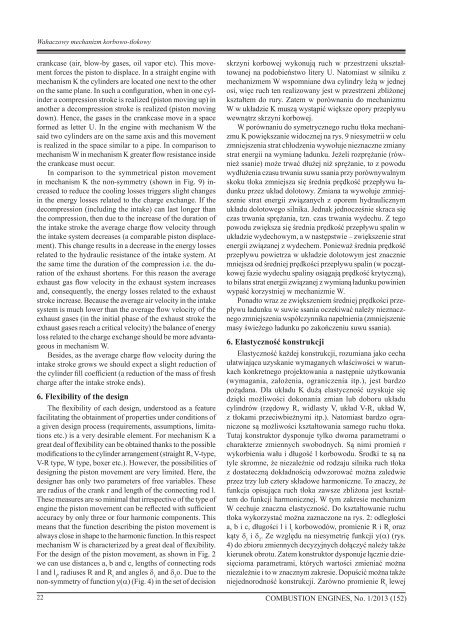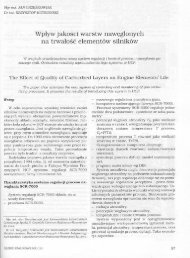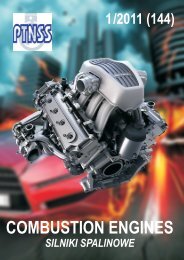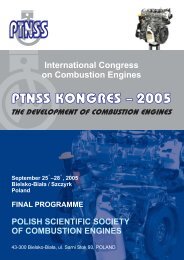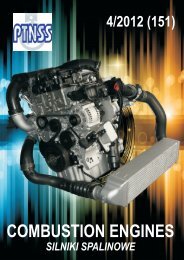Create successful ePaper yourself
Turn your PDF publications into a flip-book with our unique Google optimized e-Paper software.
Wahaczowy mechanizm korbowo-tłokowy<br />
crankcase (air, blow-by gases, oil vapor etc). This movement<br />
forces the piston to displace. In a straight engine with<br />
mechanism K the cylinders are located one next to the other<br />
on the same plane. In such a configuration, when in one cylinder<br />
a compression stroke is realized (piston moving up) in<br />
another a decompression stroke is realized (piston moving<br />
down). Hence, the gases in the crankcase move in a space<br />
formed as letter U. In the engine with mechanism W the<br />
said two cylinders are on the same axis and this movement<br />
is realized in the space similar to a pipe. In comparison to<br />
mechanism W in mechanism K greater flow resistance inside<br />
the crankcase must occur.<br />
In comparison to the symmetrical piston movement<br />
in mechanism K the non-symmetry (shown in Fig. 9) increased<br />
to reduce the cooling losses triggers slight changes<br />
in the energy losses related to the charge exchange. If the<br />
decompression (including the intake) can last longer than<br />
the compression, then due to the increase of the duration of<br />
the intake stroke the average charge flow velocity through<br />
the intake system decreases (a comparable piston displacement).<br />
This change results in a decrease in the energy losses<br />
related to the hydraulic resistance of the intake system. At<br />
the same time the duration of the compression i.e. the duration<br />
of the exhaust shortens. For this reason the average<br />
exhaust gas flow velocity in the exhaust system increases<br />
and, consequently, the energy losses related to the exhaust<br />
stroke increase. Because the average air velocity in the intake<br />
system is much lower than the average flow velocity of the<br />
exhaust gases (in the initial phase of the exhaust stroke the<br />
exhaust gases reach a critical velocity) the balance of energy<br />
loss related to the charge exchange should be more advantageous<br />
in mechanism W.<br />
Besides, as the average charge flow velocity during the<br />
intake stroke grows we should expect a slight reduction of<br />
the cylinder fill coefficient (a reduction of the mass of fresh<br />
charge after the intake stroke ends).<br />
6. Flexibility of the design<br />
The flexibility of each design, understood as a feature<br />
facilitating the obtainment of properties under conditions of<br />
a given design process (requirements, assumptions, limitations<br />
etc.) is a very desirable element. For mechanism K a<br />
great deal of flexibility can be obtained thanks to the possible<br />
modifications to the cylinder arrangement (straight R, V-type,<br />
V-R type, W type, boxer etc.). However, the possibilities of<br />
designing the piston movement are very limited. Here, the<br />
designer has only two parameters of free variables. These<br />
are radius of the crank r and length of the connecting rod l.<br />
These measures are so minimal that irrespective of the type of<br />
engine the piston movement can be reflected with sufficient<br />
accuracy by only three or four harmonic components. This<br />
means that the function describing the piston movement is<br />
always close in shape to the harmonic function. In this respect<br />
mechanism W is characterized by a great deal of flexibility.<br />
For the design of the piston movement, as shown in Fig. 2<br />
we can use distances a, b and c, lengths of connecting rods<br />
l and l t<br />
, radiuses R and R t<br />
and angles d 1<br />
and d 2<br />
o. Due to the<br />
non-symmetry of function y(a) (Fig. 4) in the set of decision<br />
skrzyni korbowej wykonują ruch w przestrzeni ukształtowanej<br />
na podobieństwo litery U. Natomiast w silniku z<br />
mechanizmem W wspomniane dwa cylindry leżą w jednej<br />
osi, więc ruch ten realizowany jest w przestrzeni zbliżonej<br />
kształtem do rury. Zatem w porównaniu do mechanizmu<br />
W w układzie K muszą wystąpić większe opory przepływu<br />
wewnątrz skrzyni korbowej.<br />
W porównaniu do symetrycznego ruchu tłoka mechanizmu<br />
K powiększanie widocznej na rys. 9 niesymetrii w celu<br />
zmniejszenia strat chłodzenia wywołuje nieznaczne zmiany<br />
strat energii na wymianę ładunku. Jeżeli rozprężanie (również<br />
ssanie) może trwać dłużej niż sprężanie, to z powodu<br />
wydłużenia czasu trwania suwu ssania przy porównywalnym<br />
skoku tłoka zmniejsza się średnia prędkość przepływu ładunku<br />
przez układ dolotowy. Zmiana ta wywołuje zmniejszenie<br />
strat energii związanych z oporem hydraulicznym<br />
układu dolotowego silnika. Jednak jednocześnie skraca się<br />
czas trwania sprężania, tzn. czas trwania wydechu. Z tego<br />
powodu zwiększa się średnia prędkość przepływu spalin w<br />
układzie wydechowym, a w następstwie – zwiększenie strat<br />
energii związanej z wydechem. Ponieważ średnia prędkość<br />
przepływu powietrza w układzie dolotowym jest znacznie<br />
mniejsza od średniej prędkości przepływu spalin (w początkowej<br />
fazie wydechu spaliny osiągają prędkość krytyczną),<br />
to bilans strat energii związanej z wymianą ładunku powinien<br />
wypaść korzystniej w mechanizmie W.<br />
Ponadto wraz ze zwiększeniem średniej prędkości przepływu<br />
ładunku w suwie ssania oczekiwać należy nieznacznego<br />
zmniejszenia współczynnika napełnienia (zmniejszenie<br />
masy świeżego ładunku po zakończeniu suwu ssania).<br />
6. Elastyczność konstrukcji<br />
Elastyczność każdej konstrukcji, rozumiana jako cecha<br />
ułatwiająca uzyskanie wymaganych właściwości w warunkach<br />
konkretnego projektowania a następnie użytkowania<br />
(wymagania, założenia, ograniczenia itp.), jest bardzo<br />
pożądana. Dla układu K dużą elastyczność uzyskuje się<br />
dzięki możliwości dokonania zmian lub doboru układu<br />
cylindrów (rzędowy R, widlasty V, układ V-R, układ W,<br />
z tłokami przeciwbieżnymi itp.). Natomiast bardzo ograniczone<br />
są możliwości kształtowania samego ruchu tłoka.<br />
Tutaj konstruktor dysponuje tylko dwoma parametrami o<br />
charakterze zmiennych swobodnych. Są nimi promień r<br />
wykorbienia wału i długość l korbowodu. Środki te są na<br />
tyle skromne, że niezależnie od rodzaju silnika ruch tłoka<br />
z dostateczną dokładnością odwzorować można zaledwie<br />
przez trzy lub cztery składowe harmoniczne. To znaczy, że<br />
funkcja opisująca ruch tłoka zawsze zbliżona jest kształtem<br />
do funkcji harmonicznej. W tym zakresie mechanizm<br />
W cechuje znaczna elastyczność. Do kształtowanie ruchu<br />
tłoka wykorzystać można zaznaczone na rys. 2: odległości<br />
a, b i c, długości l i l t<br />
korbowodów, promienie R i R t<br />
oraz<br />
kąty d 1<br />
i d 2<br />
. Ze względu na niesymetrię funkcji y(a) (rys.<br />
4) do zbioru zmiennych decyzyjnych dołączyć należy także<br />
kierunek obrotu. Zatem konstruktor dysponuje łącznie dziesięcioma<br />
parametrami, których wartości zmieniać można<br />
niezależnie i to w znacznym zakresie. Dopuścić można także<br />
niejednorodność konstrukcji. Zarówno promienie R t<br />
lewej<br />
22 <strong>COMBUSTION</strong> <strong>ENGINES</strong>, No. 1/2013 (152)


